 I climbed into the steel reinforced bunkers overlooking the Normandy landing beaches on Pointe du Hoc eighty years after the Rangers overtook the strategic German lookout 90 feet above the English Channel. I pictured a 19-year-old American boy jumping out of a PT boat into icy waters, with nothing more than a gauze bandage for comfort on a stormy dawn illuminated by gunfire.
I climbed into the steel reinforced bunkers overlooking the Normandy landing beaches on Pointe du Hoc eighty years after the Rangers overtook the strategic German lookout 90 feet above the English Channel. I pictured a 19-year-old American boy jumping out of a PT boat into icy waters, with nothing more than a gauze bandage for comfort on a stormy dawn illuminated by gunfire.
I imagined him staggering across the dunes, dodging bullets and booby traps, clawing at the red cliffs, crawling through the hedge rows, groping for life in a foreign land, shooting at the shadows that could be his own comrades. He was an American soldier killing boys/men, who would have been his friends in another time and generation.

Here rests in honor glory a comrade in arms known but to God
I am of another time and generation — an American with a French-Normand spouse and German friends. Though I’ve been to Normandy hundreds of times, I visited the Normandy American Cemetery (outside St. Laurent) just once.
Only when standing on the hallowed grounds, where Americans lay under a blanket of emerald earth, marked by 9,386 white crosses, could I truly understand the enormity of their great and tragic endeavor on June 6, 1944.
On a rainy day, Normandy’s landscape offers a bleak reminder of her sad past, but on sunny ones the murky coastline, black sea, and gray fields are transformed into a tapestry of colors. Orange cliffs drop off into purple waters. Inland reddish-brown Norman cows and pink apple blossoms dot verdant hills under powder blue skies. Soft light white washes half-timbered houses and solid stone farm houses that remain as they were centuries ago.
The beauty and tranquility of Normandy today could drive a full-grown man to tears. And I, who am too young to have understood the impact of World War II, get a lump in my throat every time I return to the dairyland of northwestern France on one of those pinch-me-I-am-dreaming days of sunshine.

my husband's village on Normandy shores
Decades ago, on one of those sunny days, I pedaled my bike past red poppy fields and green valleys where newborn calves and lambs romped. I devoured veal “à la Normande,” Camembert cheese and berries in cream. Somewhere between the first and last course, I fell in love with a Norman.
Now the sacrifices of the men of the great war, their silent testimonials of white crosses that cover the rich green hills above the beaches Utah, Gold, Juno, Sword and Omaha have taken on special meaning for me.
They are my countrymen laid to rest in my adopted country. In a sense they saved my family.

freedom for the next generation
Every time, we used to visit Dieppe, (France) to see my grandfather-in-law, he’d greet me at the gate chanting the Star Spangled Banner.
“Ah, ma petite Pat,” he’d say recounting the highlight of his career as a trumpeter in the Garde Republicaine “I’ll never forget riding Lustucru (his horse) across the courtyard. The Allies landed in Normandy on June 6, but didn’t make it to Paris until the end of August. We waited for four long years…never quit believing they’d make it.”
He’d stop and pull a handkerchief from his suit pocket and wipe his eyes, before continuing, “Never forget how I blew the trumpet that day to welcome the Americans — greatest day of my life.”
The old heart does not forget. Now even though my generation never knew the horrors of war, my young heart will remember. When I stood in front of a sea of stark, white marble crosses, I felt overwhelmed by a debt that can never be repaid.
Suddenly I knew the unknown soldier — he was my father, my brother, my countryman, who died so nobly and unknowing, so that today I might live in freedom and peace in a land whose magnificence offers its own thanks to the skies.
Rest in peace my comrades-in-arms. You have not died in vain. I wish my words could transcend time so you could know. Because of you Normandy today, like the true Normans, remains proud and gracious.


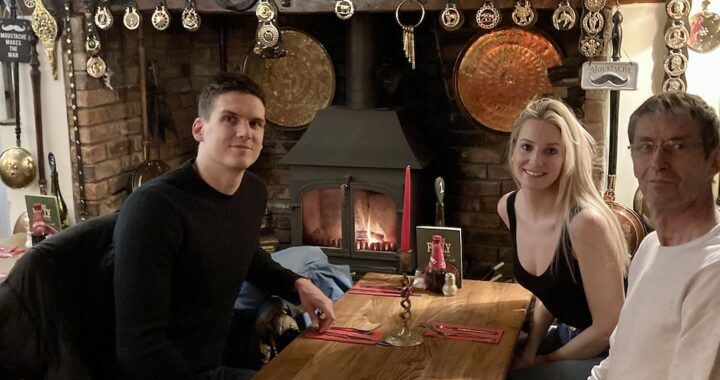
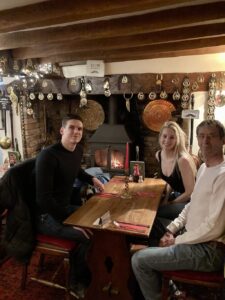 When my son married a beautiful British-Irish-Ukrainian woman, we were given an insiders peek into UK life, which begins and ends at the local pub. Going to the pub for a pint is as much a part of British life as a coca cola and Friday night football is to an American.
When my son married a beautiful British-Irish-Ukrainian woman, we were given an insiders peek into UK life, which begins and ends at the local pub. Going to the pub for a pint is as much a part of British life as a coca cola and Friday night football is to an American.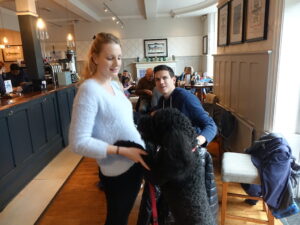
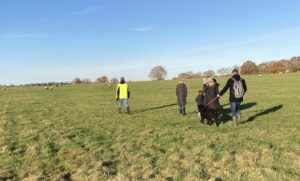 “I don’t see any signs allowing us to hike on their property,” I said.
“I don’t see any signs allowing us to hike on their property,” I said.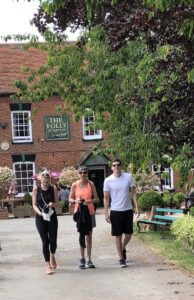 “A phone app indicates where it is okay to go,” said Larissa. “But it’s mostly common sense. You wouldn’t walk through field of donkeys or free range horses. It’s at your own risk if you try to cross a field of buffalo.”
“A phone app indicates where it is okay to go,” said Larissa. “But it’s mostly common sense. You wouldn’t walk through field of donkeys or free range horses. It’s at your own risk if you try to cross a field of buffalo.”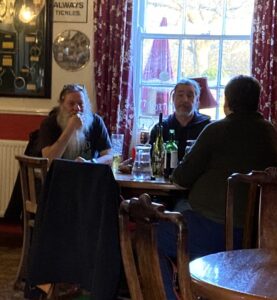 drinks, after our hike, we were so thirsty, we opted for cokes, beer, and the local cider. The little boys sat politely at the table enjoying snacks.
drinks, after our hike, we were so thirsty, we opted for cokes, beer, and the local cider. The little boys sat politely at the table enjoying snacks.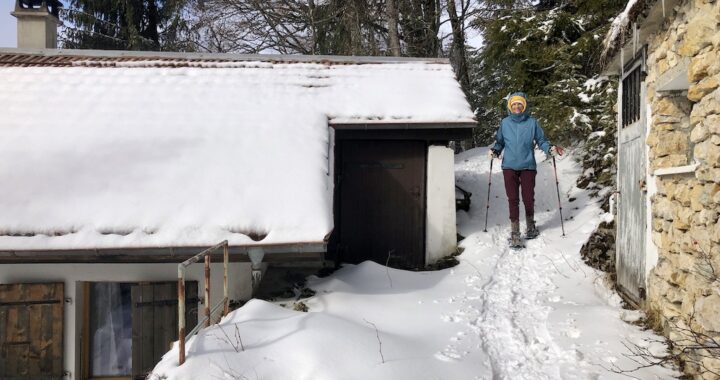
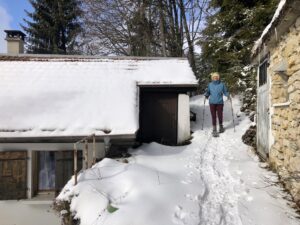 If you can walk, you can snowshoe. Sure! Snowshoeing in the Swiss Mountains makes me feel like Donald Duck waddling on the side of an iceberg in webbed feet.
If you can walk, you can snowshoe. Sure! Snowshoeing in the Swiss Mountains makes me feel like Donald Duck waddling on the side of an iceberg in webbed feet.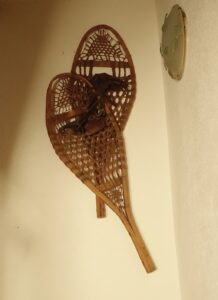 Though snowshoeing was invented in 6000BC, it was a brand new sport for me. In the old days, people made their own snowshoes - wooden-framed, rawhide-latticed wooden rackets with leather straps. I thought snowshoeing would be as simple as strapping a tennis racket to your shoe and heading out the door.
Though snowshoeing was invented in 6000BC, it was a brand new sport for me. In the old days, people made their own snowshoes - wooden-framed, rawhide-latticed wooden rackets with leather straps. I thought snowshoeing would be as simple as strapping a tennis racket to your shoe and heading out the door.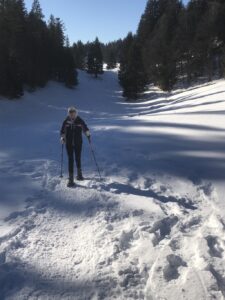 Alas, the snowshoe allows only one directional forward movement. To turn right or left or at a 180 degree angle requires the dexterity of an elite gymnast.
Alas, the snowshoe allows only one directional forward movement. To turn right or left or at a 180 degree angle requires the dexterity of an elite gymnast.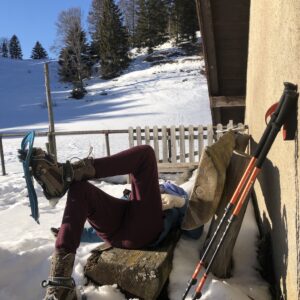 My ever patient hubby, an avid skier, encourages me to execute a "kick turn" similar to the one employed on skis.
My ever patient hubby, an avid skier, encourages me to execute a "kick turn" similar to the one employed on skis.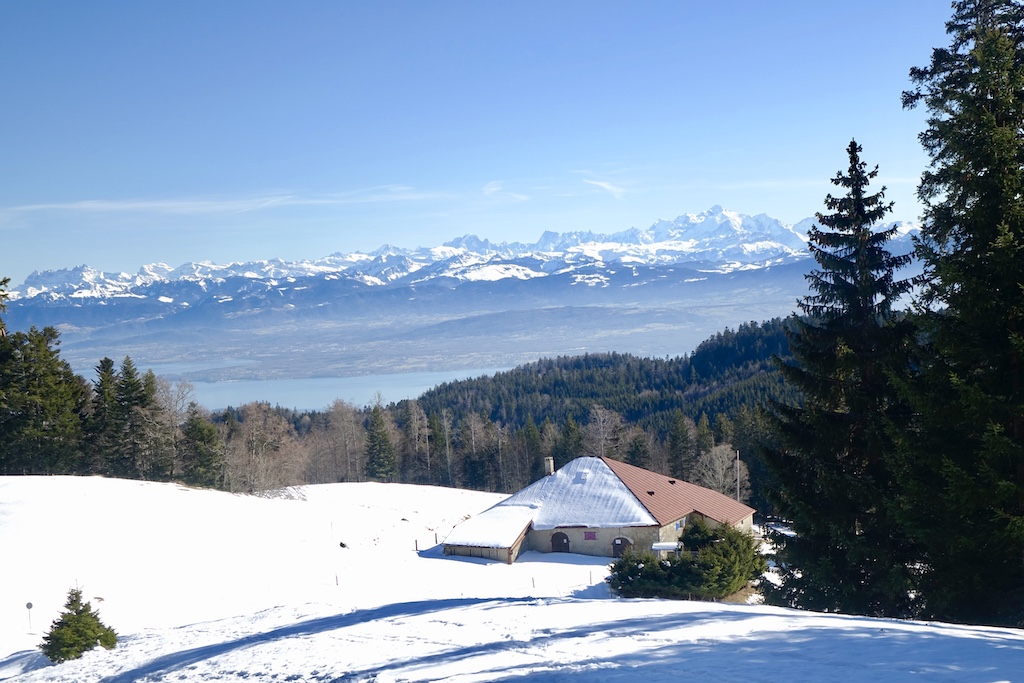
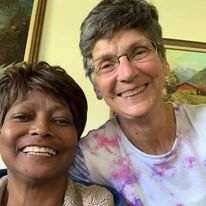
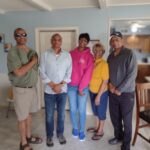 September 13, 2022. She left behind 2 daughters, a son, 2 foster sons, 2 stepsons, 1 step daughter, 18 grandchildren, several nieces and nephews, one sister, three brothers and hundreds of friends, who would swear they were somehow related too.
September 13, 2022. She left behind 2 daughters, a son, 2 foster sons, 2 stepsons, 1 step daughter, 18 grandchildren, several nieces and nephews, one sister, three brothers and hundreds of friends, who would swear they were somehow related too.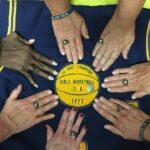 She was a catalyst uniting people from every race, ethnicity and walk of life.
She was a catalyst uniting people from every race, ethnicity and walk of life.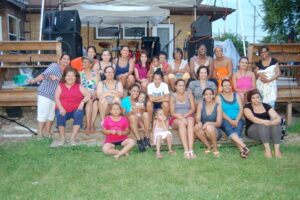
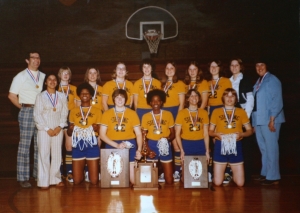 champions,
champions,
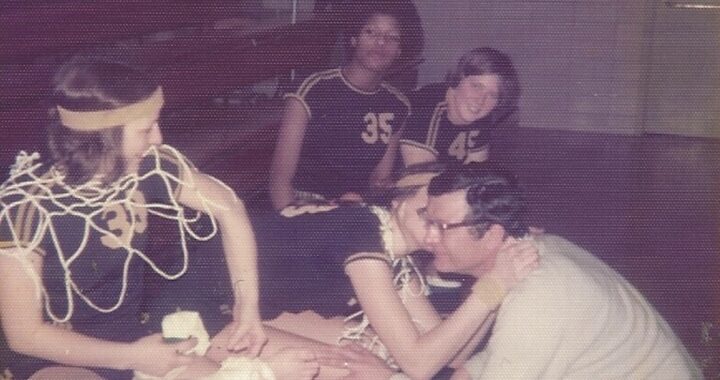
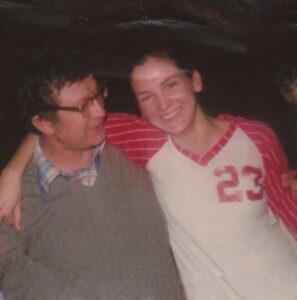 “What was it like making history becoming the first athletic scholarship recipient at Illinois State University during the groundbreaking implementation of Title IX?” asked journalists from my alma mater.
“What was it like making history becoming the first athletic scholarship recipient at Illinois State University during the groundbreaking implementation of Title IX?” asked journalists from my alma mater.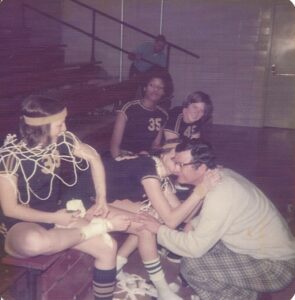 “Dad, remember all those hours we spent at the gym, all the baskets you rebounded for me.”
“Dad, remember all those hours we spent at the gym, all the baskets you rebounded for me.”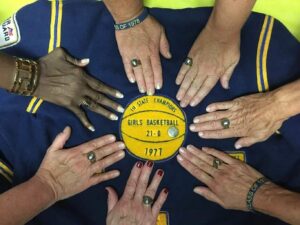 “Yep, you showed me how to throw a football, pitch a softball, spike a volleyball. You broke the rules and taught me all the things girls weren’t supposed to be doing back in the 60s and 70s. Because you did, I never doubted that I had the right to be there in the gym like the boys.”
“Yep, you showed me how to throw a football, pitch a softball, spike a volleyball. You broke the rules and taught me all the things girls weren’t supposed to be doing back in the 60s and 70s. Because you did, I never doubted that I had the right to be there in the gym like the boys.”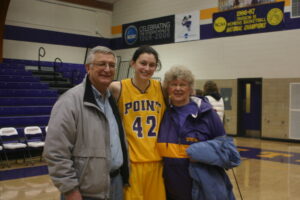
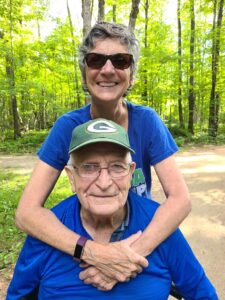 We have a ways to go, but we are getting closer. It began with dads, like you, who believed that little girls could, should and would play ball one day.
We have a ways to go, but we are getting closer. It began with dads, like you, who believed that little girls could, should and would play ball one day.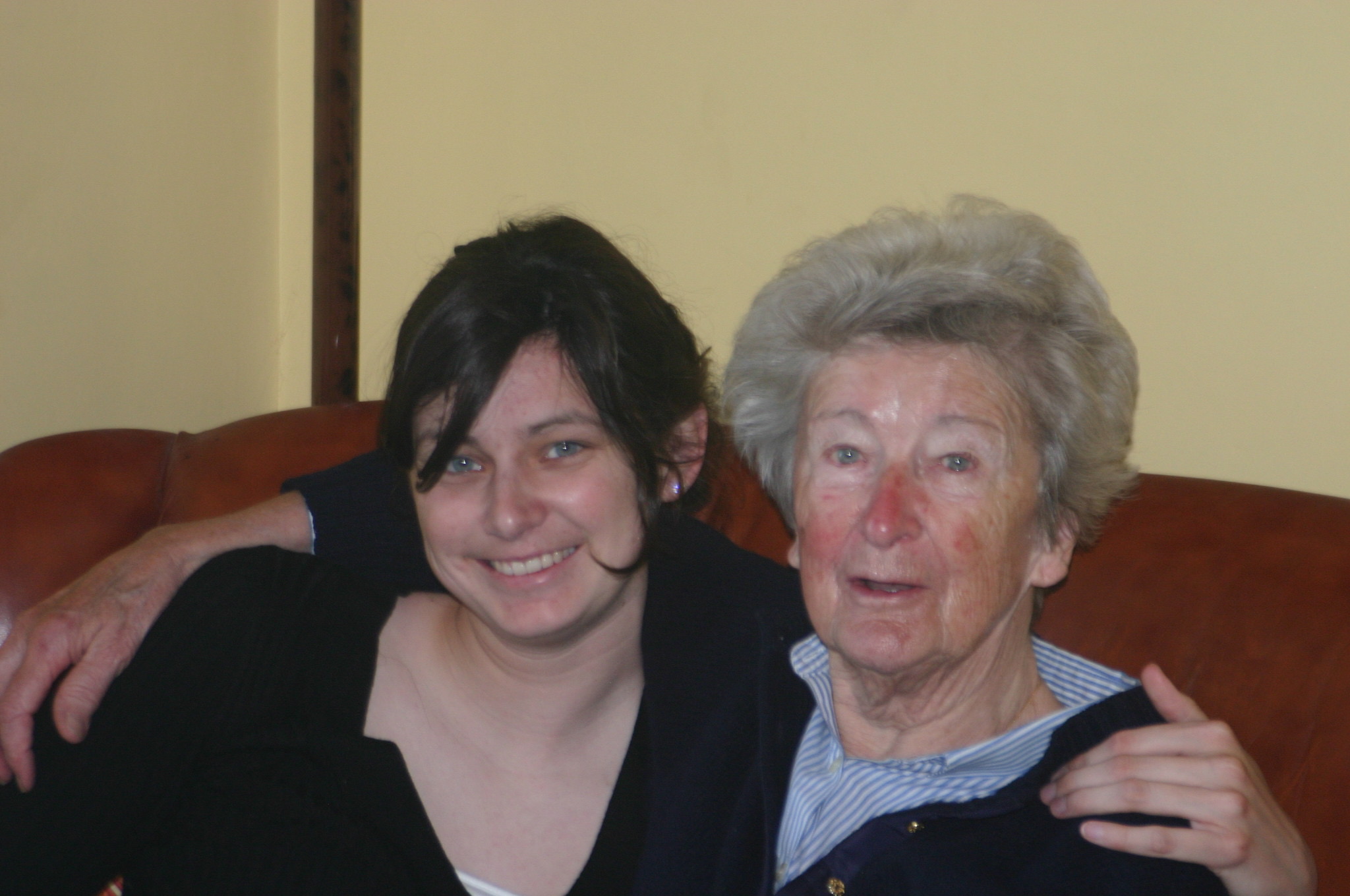
 Though she was 94 and ready to go, we are never prepared to say that final farewell to our mothers. On the day we buried our beloved Mamie, we were overcome with waves of sadness that come and go like the tide crashing the shores of Trouville by the Sea where she lived for over 6 decades. Fleeting memories of her emerged like rays of sunshine poking through the dark clouds.
Though she was 94 and ready to go, we are never prepared to say that final farewell to our mothers. On the day we buried our beloved Mamie, we were overcome with waves of sadness that come and go like the tide crashing the shores of Trouville by the Sea where she lived for over 6 decades. Fleeting memories of her emerged like rays of sunshine poking through the dark clouds.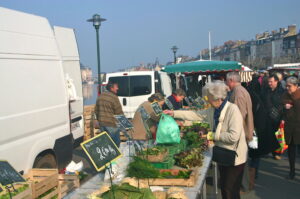
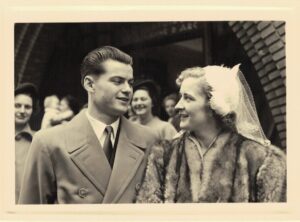
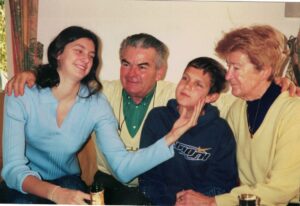
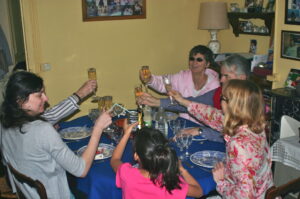 We had barely cleared the table before Mamie started preparing for the next feast, scurrying back around to the village shops filling her wicker basket with fresh supplies from the butcher, the baker and the creamery.
We had barely cleared the table before Mamie started preparing for the next feast, scurrying back around to the village shops filling her wicker basket with fresh supplies from the butcher, the baker and the creamery.  Mamie could be stormy with a sharp tongue that you never wanted to cross, but she was also sunshine filled with warmth and the first to offer consoling words in times of trouble. Ever since my car accident in France 40 years ago, like a mother hen she welcomed into her family nest and watched over me as if I were a baby chick with a broken leg.
Mamie could be stormy with a sharp tongue that you never wanted to cross, but she was also sunshine filled with warmth and the first to offer consoling words in times of trouble. Ever since my car accident in France 40 years ago, like a mother hen she welcomed into her family nest and watched over me as if I were a baby chick with a broken leg.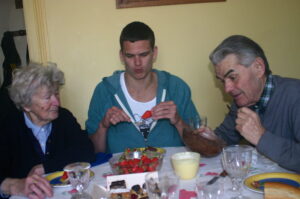 Mamie was the sun and the sea, the wind and the rain, the beach, the boardwalk, the open market, the fish sold fresh off the boat on the quay. She was Camembert, strawberries and cream, chocolate mousse, apple tart and homemade red current jelly.
Mamie was the sun and the sea, the wind and the rain, the beach, the boardwalk, the open market, the fish sold fresh off the boat on the quay. She was Camembert, strawberries and cream, chocolate mousse, apple tart and homemade red current jelly.